Table of Contents
Among the many tools available to businesses that seek to innovate their operations and offerings, the VRIO Framework offers a unique approach that helps explore an organization’s standing in the marketplace. Because it offers such an honest, unblinking appraisal of a business’s current situation, the VRIO Framework is an excellent foundation upon which to build your innovation strategies.
At its core is the process of capability mapping, which lets you fully describe your business’s strengths and weaknesses in relation to your competitors. It’s a useful way to develop a more complete view of your operations, products, and services.
In this piece, we define the VRIO Framework and its pieces and give practical examples for implementing it in your business. As always, our focus is on facilitating innovation and the development of competitive advantages that help secure your operation’s future.
What is the VRIO Framework?
The VRIO framework is a tool used in strategic management to analyze a company’s resources and capabilities to determine its competitive advantage. VRIO is an acronym. Let’s define what those letters mean:
- Value: How capabilities and resources add value to the company in terms of increasing its revenue, reducing its costs, or both.
- Rarity: What the company does—and how it does it—must be rare or unique compared to its competitors or it will not provide any competitive advantage to the company.
- Inimitability: The company’s approach to operations must be difficult to imitate or copy by its competitors.
- Organization: The company must be able to fully exploit its potential through proper organization.
The VRIO framework helps companies evaluate their resources and capabilities to determine if they can be a source of competitive advantage or not, and if a company’s resources and capabilities meet all four criteria, then they can be a source of sustainable competitive advantage.
Following a VRIO approach includes capability mapping your business, focusing on the framework’s four touchpoints. As part of an inclusive strategic planning process, VRIO helps ensure that you are using your resources in the best ways possible to achieve your strategic goals. In some cases, a complete VRIO analysis can give reason to reevaluate those strategic goals themselves as your overall strategic planning process changes based on what you learn about your work and the work of other firms in your sector.
Even now, you may be thinking about the way you do business: how does it stack up to your competitors? What do you do differently (and hopefully better) than other businesses in your sector? If you were a customer, why would you choose your place over theirs?
What Does VRIO Stand for? VRIO Framework Breakdown
Just knowing how to uncrack the acronym isn’t enough to put the VRIO Framework properly into motion.
VRIO is a tool built around a set of questions designed to uncover your business’s sustainable competitive advantage. These are unique to your way of delivering value and unlikely to be copied by competitors soon.
It’s valuable to give each of VRIO’s four categories a closer inspection.
Value: Is it Valuable?
In the VRIO framework, Value refers to the extent to which a company’s resources and capabilities contribute to the company’s overall performance, and therefore, its competitive advantage.
For a resource or capability to add value to a company, it must either:
- Increase the company’s revenue: A resource or capability that helps a company generate more revenue, either by increasing sales or by charging higher prices for its products or services
- Reduce the company’s costs: A resource or capability that helps a company reduce its costs, either by improving efficiency or by eliminating waste
In other words, a valuable resource or capability is one that helps a company achieve its strategic goals, whether those goals are related to growth, profitability, or any other aspect of the business. The more valuable a resource or capability is, the more likely it is to be a source of competitive advantage for the company.
Rarity: Is it Rare?
For the VRIO framework, Rarity references the degree to which a company’s resources and capabilities are unique or rare compared to those of its competitors. Rare resources and capabilities can provide a company with a competitive advantage because it is not widely available in the industry.
To determine if a resource or capability is rare, a company must compare it to those of its competitors. If it is common and easily accessible to other companies, it is not rare and will not provide a competitive advantage.
For example, if a company has access to a patented technology that no other company has, it can be considered a rare resource. Similarly, if a company has a highly skilled workforce with specialized knowledge or expertise, it can be considered a rare capability.
Rarity is an important factor in the VRIO framework because it helps companies identify which resources and capabilities can be best leveraged to gain a competitive advantage.
Imitability: Is it Hard to Imitate?
Imitability refers to the degree to which a company’s valuable and rare resources and capabilities can be imitated or copied. Within the VRIO Framework, a resource or capability that is easy to copy or replicate will not provide a sustained competitive advantage.
There are several ways that competitors can imitate or replicate a company’s resources and capabilities, including:
- Direct imitation: Competitors directly copy or replicate a company’s resources and capabilities. For example, they can reverse engineer a product or hire away key employees to gain access to their knowledge or expertise.
- Substitution: Competitors substitute a company’s resources and capabilities with their own. For example, they develop a similar product that achieves the same outcome as the company’s product, but which uses a different technology or approach.
- Strategic equivalence: Competitors develop a different resource or capability that is strategically equivalent to the competition’s. For example, they develop a different technology that achieves the same outcome as the company’s technology.
To maintain a sustained competitive advantage, a company must have resources and capabilities that are difficult to imitate or replicate. This can be achieved through a variety of means, such as having a strong brand reputation, having proprietary technology or intellectual property, or having unique organizational capabilities. By making it difficult for competitors to imitate its resources and capabilities, a company can continue to reap the benefits of its competitive advantage over the long term.
Organization: Is the Company Competitively Organized?
Within the context of the VRIO framework, Organization refers to the firm’s ability to utilize its resources and capabilities effectively. In other words, it assesses whether the firm has the right organizational structure, processes, and culture in place to fully leverage its valuable, rare, and difficult-to-imitate resources and capabilities.
For instance, if a company has valuable and rare resources, but lacks a strong organizational structure, it may not be able to use those resources effectively. On the other hand, a company with an effective organizational structure, processes, and culture may be able to leverage even mediocre resources to achieve a competitive advantage.
It’s essential for firms to pay close attention to their corporate organization and ensure that it aligns with their overall business strategy and goals. Properly placing the right people, processes, and systems to effectively utilize their resources and capabilities can increase a business’s odds of success in years to come.
At Digital Leadership, we know that the VRIO framework plays a crucial role in business strategy, we provide Business Model Strategy services to help companies assess and leverage their internal resources and capabilities to achieve a sustainable competitive advantage.
The UNITE VRIO Model
Within the larger context of our UNITE Business Models, the VRIO Framework guides an analysis of the company’s available resources and capabilities.
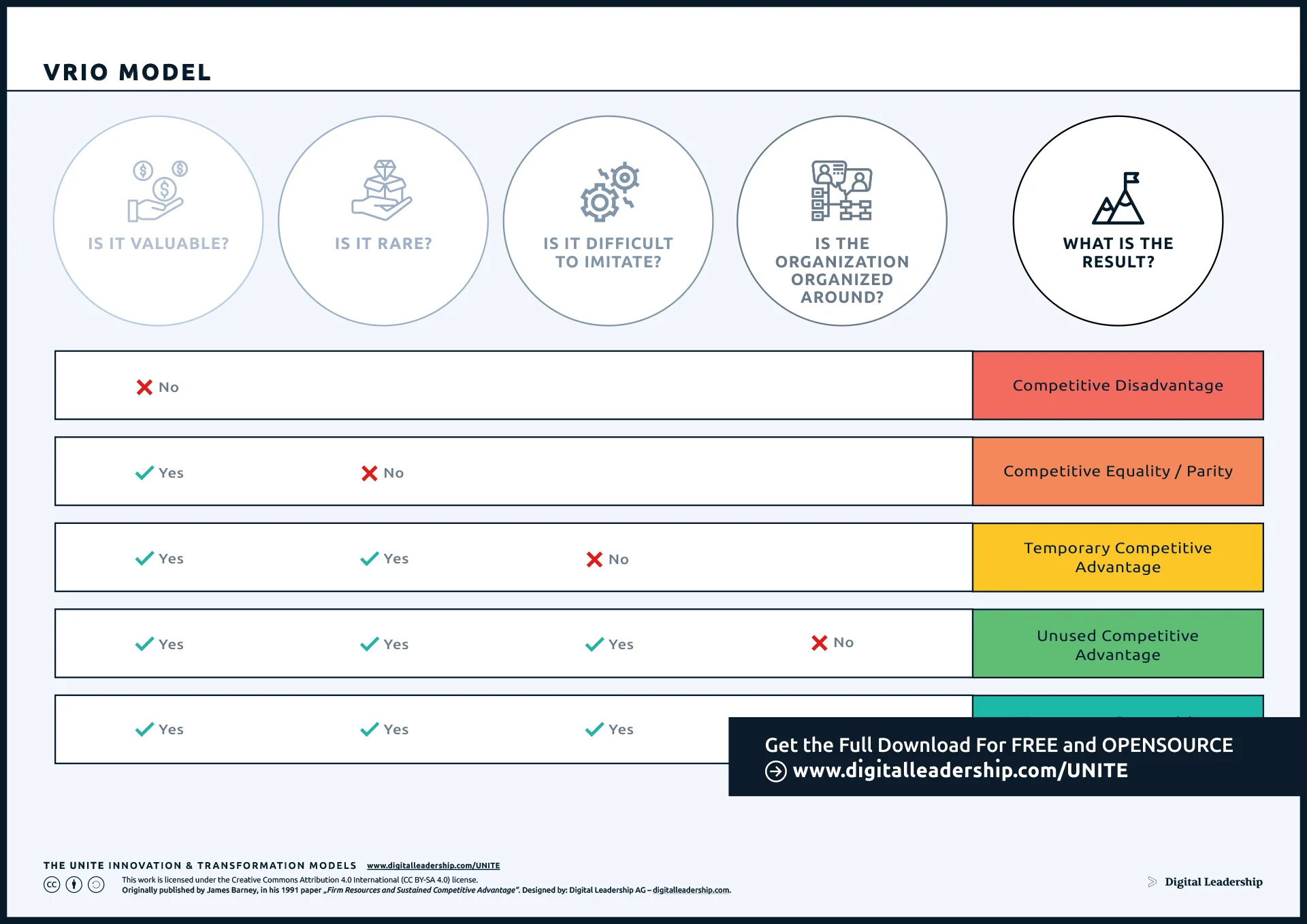
Originally published by James Barney. in his paper “Firm Resources and Sustained Competitive Advantage”. Designed by: Digital Leadership AG
Your download is now available!
You can now access the complete VRIO Framework Package, including a full presentation, related models and instructions for use.
VRIO Analysis for Strategic Planning
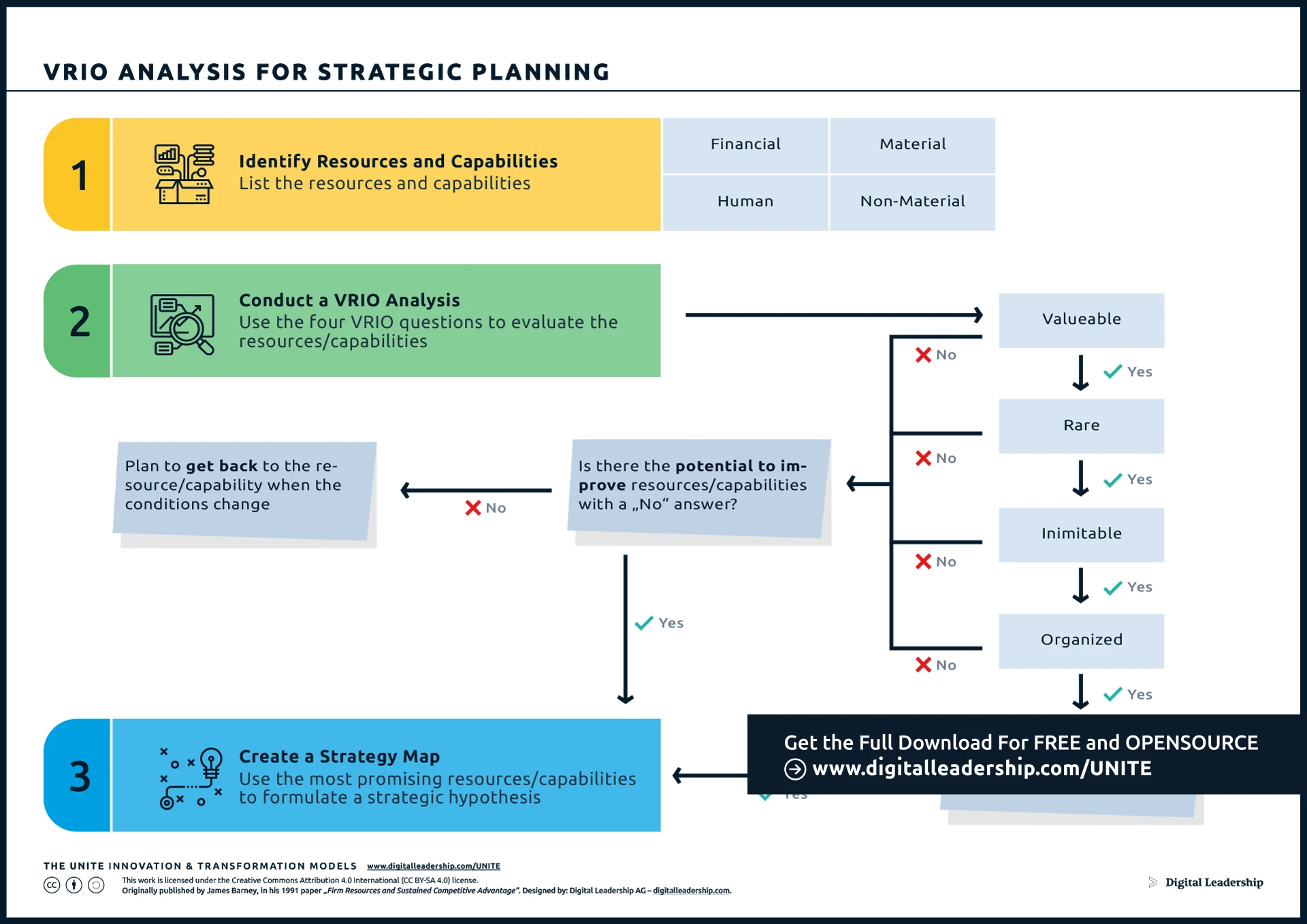
Originally published by James Barney. in his paper “Firm Resources and Sustained Competitive Advantage”. Designed by: Digital Leadership AG
Your download is now available!
You can now access the complete VRIO Analysis For Strategic Planning Framework Package, including a full presentation, related models and instructions for use.
As we’ve written elsewhere, the strategic planning process is vital for creating an atmosphere that is more conducive to your success.
A VRIO Analysis can give you the lay of the land to use as a starting point for your other strategic planning efforts. That makes it a foundational element of any business.
We recommend undertaking a VRIO Analysis regularly, and certainly early in your initial strategic planning activities.
Download The UNITE VRIO Framework Template + Full Presentation
We are happy to provide a complete package of materials to help you complete your UNITE VRIO analysis.

Originally published by James Barney. in his paper “Firm Resources and Sustained Competitive Advantage”. Designed by: Digital Leadership AG
Your download is now available!
You can now access the complete VRIO Framework Package, including a full presentation, related models and instructions for use.
VRIO Framework vs Strategy Analysis Tools
The VRIO Framework is just one of many tools a business can use to drive its innovation and long-term development, but it’s not the only one.
You wouldn’t use a hammer to fix a computer (usually); not every tool is the right choice for every job. VRIO isn’t the magic elixir for every issue challenging your business.
Consider how the VRIO Framework compares against some of the other popular business evaluation tools so you can choose the strategy analysis approach that works best for you.
VRIO Framework vs SWOT Analysis
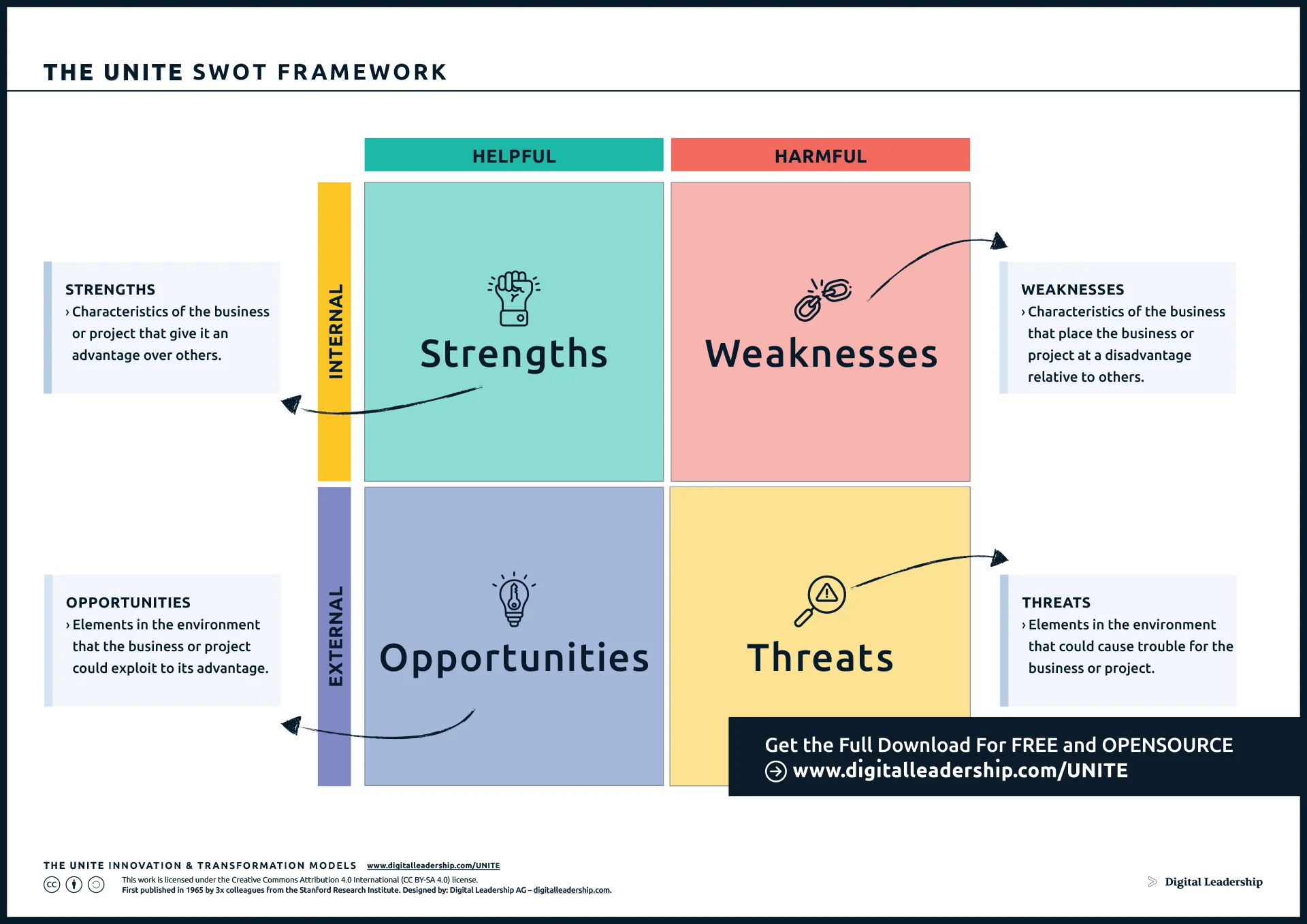
First Published in 1965 by 3x colleagues from the Stanford Research Institue. Designed by: Digital Leadership AG
Your download is now available!
You can now access the complete SWOT Framework Package, including a full presentation, related models and instructions for use.
The VRIO framework and SWOT analysis are both used in strategic management to assess a company’s internal resources and external environment. However, there are key differences between the two approaches:
- Focus: The VRIO framework focuses primarily on the internal resources and capabilities of a firm, whereas SWOT analysis considers both internal and external factors.
- Objectives: The VRIO framework aims to assess a firm’s potential to gain a competitive advantage through its resources and capabilities, while SWOT analysis aims to identify a firm’s strengths, weaknesses, opportunities, and threats.
- Criteria: The VRIO framework uses four criteria—Value, Rarity, Imitability, and Organization—to evaluate a firm’s resources and capabilities, while SWOT analysis uses four categories—Strengths, Weaknesses, Opportunities, and Threats—to assess a firm’s overall situation.
- Timeframe: The VRIO framework is more focused on long-term sustainable competitive advantage, while SWOT analysis is more focused on short-term considerations.
- Limitations: The VRIO framework is more specific and can provide a deeper analysis of a company’s resources and capabilities, but it may not capture all external factors affecting a firm’s competitiveness. In contrast, SWOT analysis provides a broader overview of a firm’s situation, but may not provide enough detail to develop a specific strategy.
Both the VRIO framework and SWOT analysis are useful tools for strategic management, but they have different objectives, criteria, and focus areas. The VRIO framework is more specific and provides a deeper analysis of a company’s internal resources and capabilities, while SWOT analysis provides a broader overview of a firm’s overall situation, including external factors.
VRIO Framework vs PESTLE Analysis
Again, the VRIO Framework and PESTLE Analysis are both commonly used tools in strategic management, but there are several differences between the two:
- Focus: The VRIO Framework focuses on the internal resources and capabilities of a firm, while the PESTLE Analysis focuses on the external environment.
- Objectives: The VRIO Framework aims to assess a firm’s potential to gain a competitive advantage through its resources and capabilities, while the PESTLE Analysis aims to identify external factors affecting a firm’s competitiveness.
- Criteria: The VRIO Framework uses its four criteria to evaluate a firm’s resources and capabilities, while the PESTLE Analysis considers six external factors—Political, Economic, Social, Technological, Legal, and Environmental—to assess a firm’s external environment.
- Timeframe: The VRIO Framework is more focused on long-term sustainable competitive advantage, while the PESTLE Analysis is more focused on short-term considerations.
- Limitations: VRIO is more specific and can provide a deeper analysis of a company’s internal resources and capabilities, but it may not capture all external factors affecting a firm’s competitiveness. On the other hand, the PESTLE Analysis provides a broader overview of a firm’s external environment but may not provide enough detail to develop a specific strategy.
The VRIO Framework is more specific and provides a deeper analysis of a company’s internal resources and capabilities, while the PESTLE Analysis provides a broader overview of a firm’s external environment, including political, economic, social, technological, legal, and environmental factors.
VRIO Framework vs Porter’s Five Forces
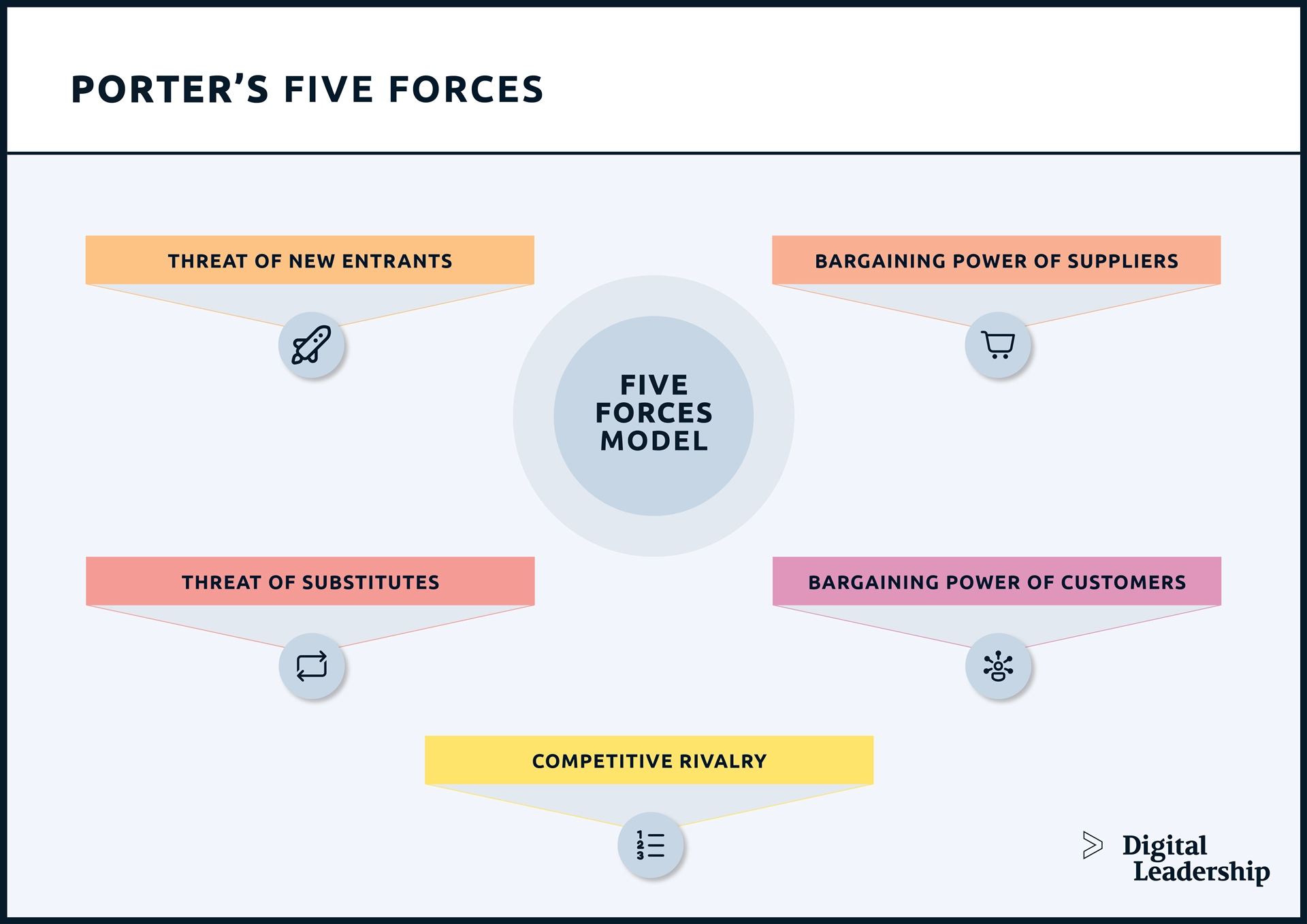
Now compare the VRIO framework with Porter’s Five Forces:
- Focus: The VRIO Framework focuses on a firm’s internal resources and capabilities, while Porter’s Five Forces framework focuses on the external industry environment.
- Objectives: VRIO assesses a firm’s potential to gain a competitive advantage through its resources and capabilities, while Porter’s Five Forces identifies the industry forces that affect a firm’s profitability.
- Criteria: The VRIO Framework criteria evaluate an organization’s resources and capabilities, while Porter’s Five Forces consider five industry forces: the threat of new entrants, the bargaining power of suppliers, the bargaining power of buyers, the threat of substitutes, and the intensity of competitive rivalry.
- Timeframe: The VRIO Framework is more focused on long-term sustainable competitive advantage, while Porter’s Five Forces is more focused on short-term considerations.
- Limitations: The VRIO Framework is more specific and provides a deeper analysis of a company’s internal resources and capabilities, but it may not capture all external factors affecting a firm’s competitiveness. Porter’s Five Forces provides a broader overview of the industry environment but may not provide enough detail to develop a specific strategy.
The VRIO Framework is more specific and provides a deeper analysis of a company’s internal resources and capabilities, while Porter’s Five Forces provides a broader overview of the external industry environment that affects a firm’s profitability.
The VRIO Framework also elegantly ties into the concept of Porter’s Value Chain, given especially how VRIO requires you to consider how your resources contribute to value creation and product delivery.
For a deeper understanding of Porter’s Five Forces and other valuable tools in the world of innovation, check out our book “How to Create Innovation.” It’s the ultimate guide to innovation and digital transformation, offering a wide range of tools and models to enhance your knowledge and improve your strategies, ensuring great success in the competitive business world.
VRIO Framework vs Balanced Scorecard
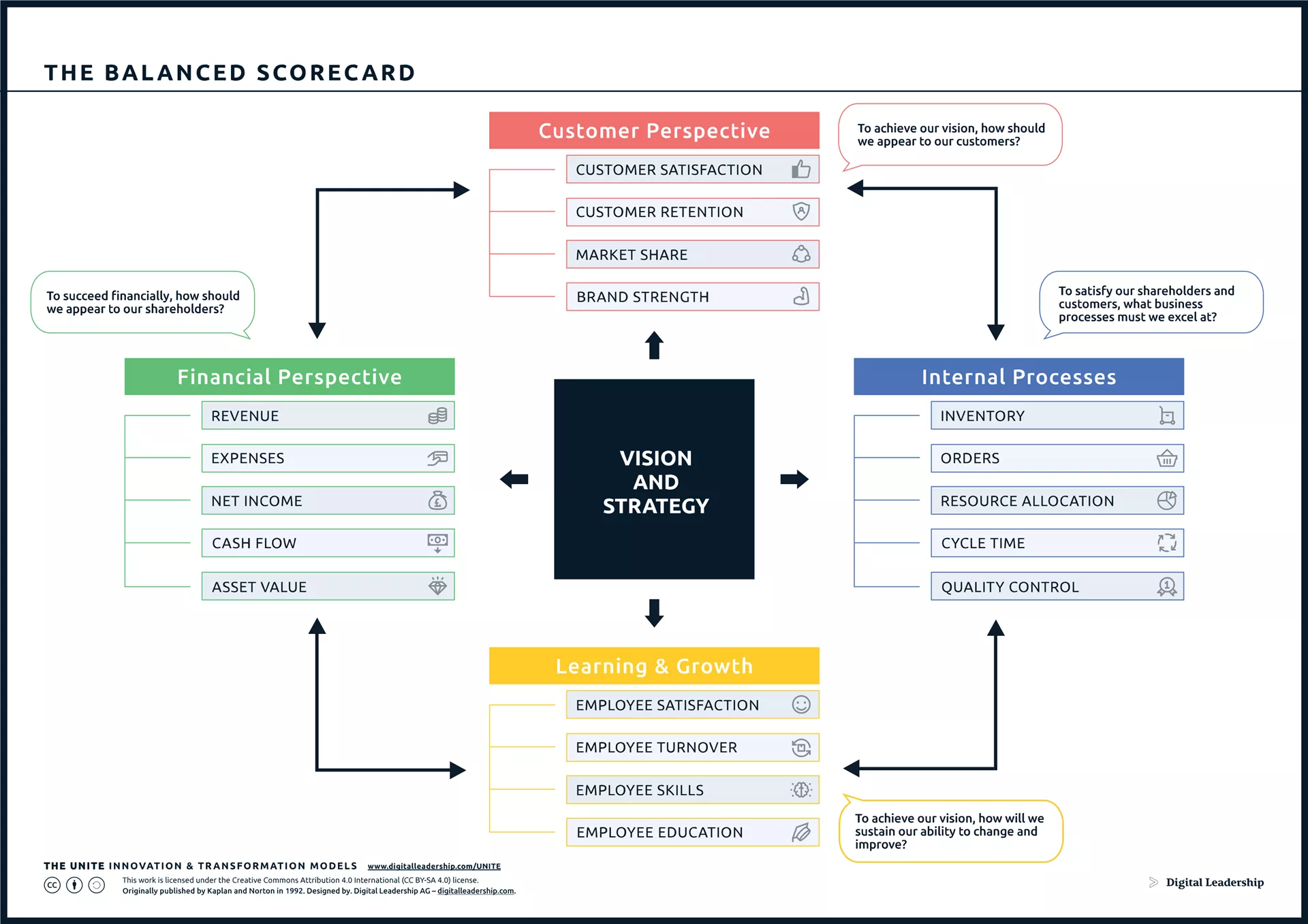
Originally published by Kaplan and Norton in 1992. Designed by: Digital Leadership AG
Your download is now available!
You can now access the complete Balanced Scorecard Package, including a full presentation, related models and instructions for use.
Moving on, we now compare the VRIO Framework to the Balanced Scorecard approach:
- Focus: The VRIO Framework focuses on a firm’s internal resources and capabilities, while the Balanced Scorecard focuses on measuring and monitoring a firm’s performance.
- Objectives: VRIO Framework assesses a firm’s potential to gain a competitive advantage through its resources and capabilities, while the Balanced Scorecard builds a comprehensive view of a firm’s performance by considering multiple perspectives.
- Criteria: The VRIO Framework evaluates a firm’s resources and capabilities through its four criteria, while the Balanced Scorecard considers four perspectives: Financial, Customer, Internal Processes, and Learning and Growth.
- Timeframe: The VRIO Framework is more focused on long-term sustainable competitive advantage, while the Balanced Scorecard is more focused on both short-term and long-term performance.
- Limitations: VRIO is more specific and provides a deeper analysis of a company’s internal resources and capabilities, but it may not capture all external factors affecting a firm’s competitiveness. The Balanced Scorecard, on the other hand, provides a broader overview of a firm’s performance, but may not provide enough detail to develop a specific strategy.
The VRIO Framework is more specific and provides a deeper analysis of a company’s internal resources and capabilities, while the Balanced Scorecard aims to provide a comprehensive view of a firm’s performance by considering multiple perspectives.
How to use VRIO Framework to Create a Sustainable Competitive Advantage: A Step-By-Step Guide
Let’s look at how to use the VRIO Framework in your business. We hope this is a guide you can put into motion immediately.
If you have any questions about the VRIO Framework, or other innovation models and techniques, reach out to one of the Digital Leadership experts today.
Step (1): Identify your Capabilities & Key Resources
The first step in a VRIO analysis is to identify the company’s resources and capabilities. This includes tangible resources such as assets, facilities, and technology, as well as intangible resources such as brand reputation, patents, and customer loyalty.
Your resources can take many shapes, so be sure to consider everything you have available. Include the following:
Financial
Money on hand, as well as savings and investments that can be liquidated.
Material
Inventory, infrastructure, property, machinery, and other tangible resources.
Human
Skills and experience possessed by your workforce.
Non-Material
Intellectual property, brand awareness, expertise, and reputation.
The UNITE Capability Map
The UNITE Capability Map can make evaluating your business easier.
Business capability mapping is an excellent way to create a tangible representation of everything your business can bring to bear on a problem—the solution to which, of course, is the value you’re delivering to customers.
Equally beneficial is capability mapping’s usefulness in identifying your business’s shortcomings.
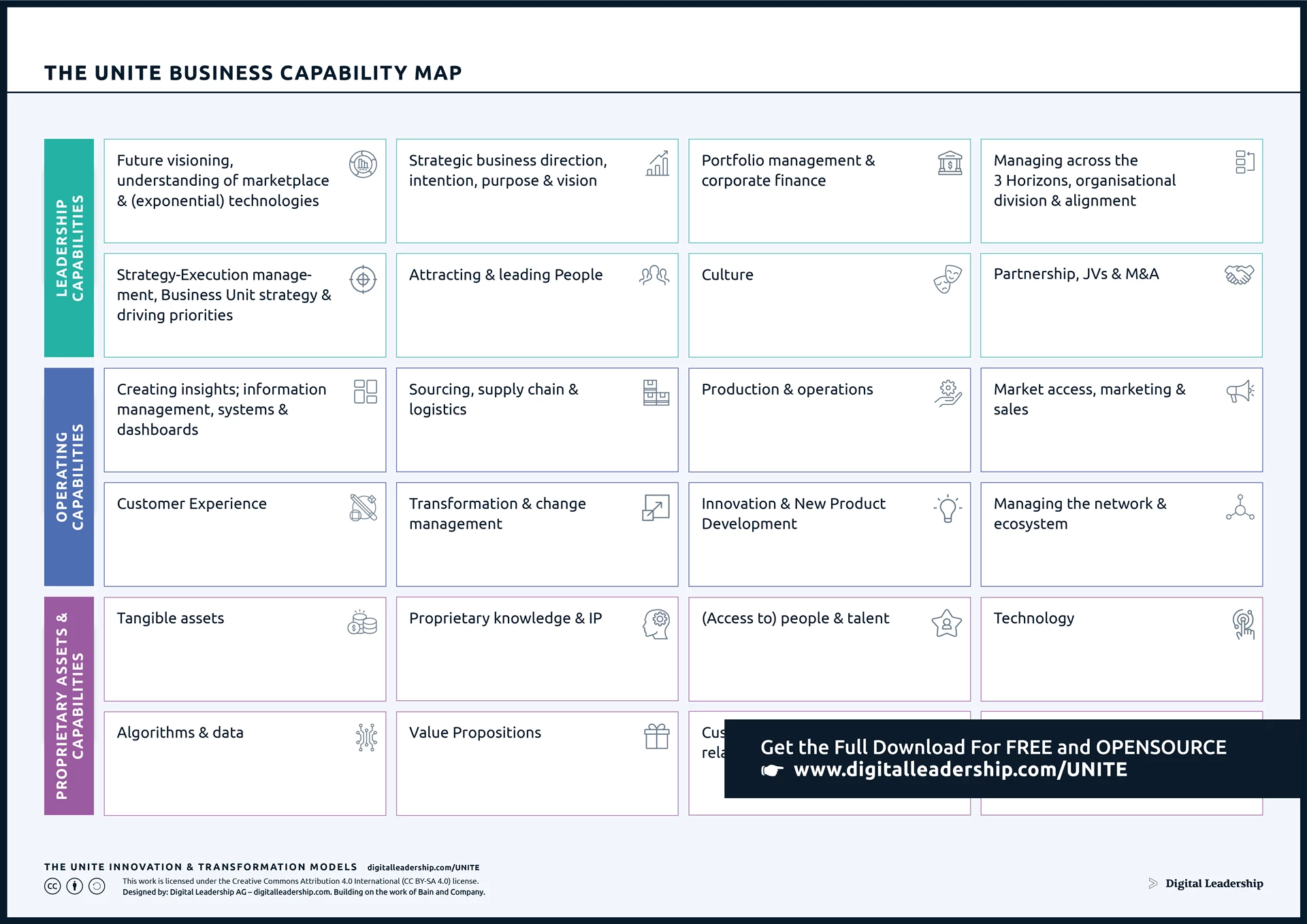
Designed by: Digital Leadership AG – Building on the Work of Bain & Company
Download the complete Business Capability Map package, including instructions for putting it to work for you today.
Step (2): Evaluate the Value of your Resources
The next step is to assess the value of each resource or capability. This involves determining how the resource or capability contributes to the company’s competitive advantage or ability to achieve its strategic objectives.
Remember that Value can either add to your business’s income, or it can reduce your business’s costs.
Step (3): Evaluate your Resources’ Rarity
The rarity of a resource or capability refers to how unique it is compared to those of competitors. If a resource or capability is rare, it provides a competitive advantage.
Step (4): Evaluate the Imitability of your Resources
If a resource or capability is difficult to imitate, it provides a sustained competitive advantage. Carefully consider how your competitors could copy either your products or your methods.
Step (5): Evaluate the Alignment of your Organization
A well-organized resource or capability provides a competitive advantage. Is your business organized around your business’s strategies, goals, and purpose?
Step (6): Identify Areas for Improvement
Based on the results of the VRIO analysis, the company identifies its strengths and weaknesses. Begin the development of strategic options to leverage your business’s strengths and address its weaknesses.
Step (7): Monitor & Update
Continue to monitor the basis of your evaluations so you can adjust your report based on shifts in the business environment. Pay particular attention to operational changes you’ve made. Suture those changes to KPIs and establish and measure metrics of success.
Download The UNITE VRIO Framework Template
We’ve made it easy for you to evaluate your business using the VRIO Framework.

Originally published by James Barney. in his paper “Firm Resources and Sustained Competitive Advantage”. Designed by: Digital Leadership AG
Your download is now available!
You can now access the complete VRIO Framework Package, including a full presentation, related models and instructions for use.
Advantages & Limitations of the VRIO Framework
We believe the VRIO Framework is a useful tool as part of an overall approach to growth and innovation strategy. Of course, no one tool is perfect, and VRIO has its particular strengths along with some specific weaknesses.
VRIO Framework Advantages
Let’s first consider some of the VRIO Framework’s advantages:
- Focus on Internal Resources: The VRIO Framework focuses on a company’s internal resources—such as its knowledge, skills, and capabilities—which can be more easily controlled and manipulated compared to external factors such as market conditions. This makes it easier for companies to identify areas where they can develop a competitive advantage.
- Sustainable Competitive Advantage: The Framework helps companies identify resources and capabilities that can provide a sustained competitive advantage. Through the VRIO Framework’s evaluation, a company can determine whether it has the potential to create a sustainable competitive advantage.
- Better Decision-Making: It’s advantageous to take a structured approach to evaluating a company’s resources and capabilities, which can help managers make better decisions. Managers using an appropriately systemic approach can avoid biases and make more informed decisions.
- Internal Analysis: The VRIO Framework provides a detailed internal analysis of a company’s resources and capabilities, which can help identify areas where a company needs to improve. The company can focus its resources and investments in areas where it can create the most value.
- Competitive Positioning: When companies understand their competitive position, they can develop a strategy that leverages their strengths and addresses their weaknesses.
VRIO Framework Limitations & How You Can Overcome Them
Nothing is ever perfect, and the VRIO Framework is no different in that regard. Thankfully, there are some ways to overcome VRIO’s limitations.
- Limited scope: The VRIO Framework focuses solely on a company’s internal resources and capabilities, which may not take into account the impact of external factors, such as market trends, regulatory changes, or the actions of competitors. To overcome this limitation, businesses can use the VRIO Framework in combination with other tools, such as PESTLE analysis or Porter’s Five Forces, to gain a more comprehensive understanding of the business environment.
- Subjectivity: The Framework relies on subjective judgments about the value, rarity, imitability, and organization of a company’s resources and capabilities. These judgments can be influenced by biases or incomplete information, leading to inaccurate assessments. However, businesses can use multiple perspectives and gather input from various stakeholders—including employees, customers, or industry experts—to reduce bias and increase the accuracy of the assessment.
- Dynamic nature of a business: The VRIO Framework assumes that a company’s resources and capabilities are static and unchanging. However, in reality, a company’s resources and capabilities may evolve over time, becoming more or less valuable, rare, or difficult to imitate. Businesses can conduct regular reviews of their resources and capabilities, and update their assessments as needed to reflect changes in the business environment to overcome the Framework’s lack of scope.
- Resource constraints: A company doesn’t have unlimited resources to invest in developing and leveraging its resources and capabilities. Companies may face resource constraints, such as limited financial resources, time, or expertise. To overcome this limitation, businesses can prioritize their resources and investments in areas where they can create the most value and seek out partnerships or collaborations to access additional resources or expertise.
- Lack of actionability: The VRIO Framework provides an assessment of a company’s resources and capabilities but does not provide guidance on how to leverage them to create a competitive advantage. Businesses can use the insights gained from the VRIO analysis to develop a strategic plan that leverages their strengths, addresses their weaknesses, and aligns with their overall business goals.
Closing Thoughts
The VRIO Framework is just one of the many tools you should be using to help secure your business’s future.
As we’ve stated, it has its limitations, but even then, the VRIO Framework is a powerful tool to drive innovation and develop your competitive advantage.
We’re here to help. If you have any questions we haven’t addressed in this article, please reach out. We’re eager to help you and your business today!
Frequently Asked Questions
1) Can the VRIO Framework be applied to non-business organizations, such as non-profits or government agencies?
Of course!
The VRIO Framework is a tool for analyzing the resources and capabilities of an organization to determine whether it can provide a sustained competitive advantage. As such, it can be used by any organization that seeks to evaluate its strengths and weaknesses.
For non-profits, the VRIO framework can be applied to identify the unique resources and capabilities that help them achieve their mission.
In the case of governmental agencies, VRIO can assess their ability to deliver services effectively and efficiently.
2) What are some common mistakes companies make when using the VRIO framework, and how can they be avoided?
We find the most common mistakes are a result of failing to consider all the resources at a business’s disposal, including:
There are a few common mistakes that companies make when using the VRIO framework. These include:
- Focusing solely on internal resources
- Overlooking the importance of intangible resources
- Not considering the dynamic nature of resources
But you can avoid these mistakes with some simple attention to detail, including conducting a comprehensive initial analysis, properly considering both tangible and intangible resources, and regularly reevaluating your resources.
3) Can the VRIO framework be used in conjunction with other business analysis tools, such as Porter’s Five Forces or the Balanced Scorecard? If so, how?
Yes, the VRIO framework can be used in conjunction with other business analysis tools, such as Porter’s Five Forces or the Balanced Scorecard. In fact, using multiple frameworks can provide a more comprehensive understanding of a company’s competitive position and help identify areas for improvement.
Combining multiple frameworks can help provide a more holistic view of a company’s competitive position and identify opportunities for improvement across multiple dimensions.
4) What is the relation between Vrio Framework and Business model innovation?
Business model innovation often involves assessing and modifying various aspects of how a business creates, delivers, and captures value, and the VRIO framework can play a role in this process in the following ways:
- Resource and Capability Assessment: The VRIO framework is used to evaluate a firm’s internal resources and capabilities for their potential to provide a sustainable competitive advantage. When a business is considering business model innovation, it often involves changes to its existing resources and capabilities. VRIO can help assess whether these new or modified resources will contribute to a competitive advantage. If the new resources or capabilities are valuable, rare, and difficult to imitate, they may be a critical component of the innovative business model.
- Identifying Key Value Drivers: Business model innovation aims to create new sources of value or improve existing ones. VRIO analysis can help identify which resources and capabilities are central to the new value proposition. By assessing which elements are valuable, rare, and difficult to imitate, businesses can prioritize the most critical components for their innovation efforts.
- Sustainability of Innovation: Business model innovations are not valuable if they cannot be sustained over time. VRIO analysis helps in understanding the long-term sustainability of the innovation. It can assess whether the modified business model’s resources and capabilities will remain valuable and rare and whether they can be protected from imitation by competitors.
- Organizational Alignment: Business model innovation often requires changes in how an organization operates and organizes its resources. VRIO’s “O” (Organization) component is directly relevant here. It assesses whether the organization is effectively structured to leverage the new resources and capabilities to create value for the business.































 Book How to Create Innovation
Book How to Create Innovation